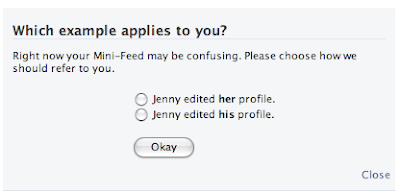|
|
A couple of days ago, the following message popped up on my Facebook homepage and has yet to disappear:

It would seem those who choose not to identify as “his” or “her” has become an issue of some urgency for Facebook. They’ve written a blog post about the issue:
As Facebook grows in other languages, we are learning a lot about what the “Facebook Experience” is like for people around the world. One of the first challenges was getting words that are really long in other languages to fit on the screen properly. Recently, we’ve been figuring out how to deal with a new challenge—grammar. Ever see a story about a friend who tagged “themself” in a photo? “Themself” isn’t even a real word. We’ve used that in place of “himself or herself”. We made that grammatical choice in order to respect people who haven’t, until now, selected their sex on their profile. However, we’ve gotten feedback from translators and users in other countries that translations wind up being too confusing when people have not specified a sex on their profiles. People who haven’t selected what sex they are frequently get defaulted to the wrong sex entirely in Mini-Feed stories. For this reason, we’ve decided to request that all Facebook users fill out this information on their profile. If you haven’t yet selected a sex, you will probably see a prompt to choose whether you want to be referred to as “him” or “her” in the coming weeks. When you make a selection, that will appear in Mini-Feed and News Feed stories about you, but it won’t be searchable or displayed in your Basic Information. We’ve received pushback in the past from groups that find the male/female distinction too limiting. We have a lot of respect for these communities, which is why it will still be possible to remove gender entirely from your account, including how we refer to you in Mini-Feed. We hope this change will make the Facebook experience even better across the world. Let us know if you have any thoughts about this on our suggestions page. Naomi is a Product Manager at Facebook.
Apparently it’s an issue of being lost or, as the case may be, misconstrued in translation.
I didn’t select a sex, just clicked ‘close’; confusion regarding such things has a salubrious effect on consciousness, methinks.
It’s been difficult to blog recently, difficult to find my own words and articulate my own thoughts amidst this constant flood of information. However, I have been absorbing quite a lot, thanks in large part to my ever-so-useful Google homepage, in which I can organize the well over a dozen RSS feeds I read regularly, my gmail, the livejournals and podcasts of my friends, my del.icio.us bookmarks, and the handful of widgets I find the most useful (such as Google Maps, blog search, Google Docs, wikipedia and YouTube).
I’ve just returned from yet another venture through the blooming fields of Facebook, having added two more applications:
SGO: Concerns sex and gender orientation. Facebook’s options are rather limited, however with the addition of this app one can differentiate between sex and gender, gender identity and gender presentation, as well as specify who one is interested in. I recall a Facebook group that advocated more diverse and politically correct options for sex and gender orientation, as well as allowing users to articulate more than one relationship- these options are now available. For more information, check out the SGO FAQ and the Relationships++ application, which allows one to specify more forms of “Looking For” (such as swinging and polyamory) as well as multiple forms of relationships (such as BFFs, civil unions, and “seeing other people than”).
Socialmoth: Users can post anonymous confessions that are read by other users. The most touching or intriguing gain “hearts” that other users give in response. Thus far, I’ve yet to see anything particularly spicy… most confessions follow along the lines of “I wish he loved me back.” or derogatory “flames”.
An update on the “Honesty Box” app: Thus far, I’ve learned two things about myself: I inadvertantly offended someone, who found it best to let me know only in the most aggravatingly anonymous form possible, and that I’m “out of control”. Assessment: the inclusion of this app has thus far served only to make me slightly paranoid and quite self-conscious.
—
I read a blog post recently regarding MySpace’s plan to build and expand MySpace TV, as well as allowing third party applications. Such moves are being made in order to maintain their top social network status amidst the frenzy surrounding YouTube and Facebook. MySpace’s reputation for processor-heavy, cluttered profile pages has prompted a growing concern over Facebook’s development. Whatevs.
Facebook has recently integrated the Developer’s Platform into its core site, allowing users to choose from over 200 applications.
Among the most popular:
-Top Friends: Choose up to 24 friends to display directly on your profile, allowing you to both a) play favorites and b) shorten the number of clicks it takes too check up on your best friends.
-Free Gifts: Don’t feel like giving to charity? Give little gifts (represented as occasionally clever icons) for your friends to display proudly on their profiles- for free!
-Video: Yes yes, now you can post videos on your profile also! Or send video messages!
-Flikster Movies: Share what movies you’ve seen recently with your friends- great for recommendations.
-iLike: Add music that you’ve been playing through iTunes. It also lists upcoming concerts, allowing you to see who else may be attending.
-Trakzor: This only works if your friends install the application also- but you can see who is viewing your Trakzor page. Note- stalking is still a 100% safe and viable Facebook activity- if you don’t want to be tracked, simply don’t visit people’s Trakzor pages.
My personal favorites:
-Graffiti: Placed right above a profile’s Wall, allows friends to draw on your wall.
-Games: Play a Battleship-type game (using sushi as playing pieces as opposed to ships), strip blackjack (they censor out the genitalia- rated E for everyone!), and more (play tetris while you wait for other users to join your game- either random or from one of your networks).
-Honesty Box: Allow your friends to anonymously tell you exactly what they think of you (don’t worry, it’s private- you can revel in your shame/anger/surprise in peace!). However, like the Trakzor app, your anonymous commentator also needs to install the app in order to send you a message. Once again, a useless application unless/until it becomes popular.
-(fluff)Friends: Add little graphic friends to your profile (mine is a flying giraffe I named Sasha).
-Extended Info: Add more info boxes to your profile (I added “Things I Am Looking At Right Now” and “Summer Schedule”).
-Wis.dm: A Q&A site, Wis.dm’s Facebook app asks questions of users, pairing them to other users who’ve answered similarly. Users gain points as they answer questions- a veritable smorgasbord of possibilities for advertisers.
—-
MySpace is working on a news site, currently in Beta: http://news.myspace.com . I especially like the integration of Event news from LinkedIn and MeetUp. They’ve also recently developed a profile customizer utility that’s incorporated within the site, removing the necessity of seeking external MySpace Layout sites for the non-HTML-savvy.
Also of note: For some reason or another, the number of pornography accounts requesting my friendship is exploding. At least they are easy to swiftly detect and decline- a game of “spot-the-thong”.
In the third of a continuing series of Facebook research projects, Lampe et al; drew data from over 30,000 Facebook profiles at Michigan State University in order to uncover the relationships between the amount and type of profile elements presented and number of friends.
Walther’s Social Information Processing Theory: Online, lack of traditional cues leads to the development of new social cues, such as spelling ability.
Signaling Theory: Profile elements are signals used by individuals to communicate personal qualities that are interpreted by others in order to make judgments.
-Donath differentiates between assessment signals (which are observable qualities) and conventionial signals (indicated through social conventions). Online signals are generally conventional.
-In the world of Facebook, relationships are generally formed first offline. Thus, the structure of Facebook encourages honesty in profiles. Dishonesty is typically playful or ironic in nature.
-The researchers propose that the number of legitimate conventional signals included in Facebook profiles is proportionate to the size of one’s online social network, as well as the signaling value of less verifiable cues (such as interests).
Common Ground Theory: Profile creation is motivated by a desire “to establish common frames or reference that enhance mutual understanding.”
-Community membership is integral to assessing the amount of shared understandings, working to establish common frames of reference.
-Information derived from Facebook profiles works much in the same way as face-to-face “interviewing”, indicating shared common ground that may enhance understanding between individuals (such as shared location or academic major).
Transaction Cost Theory: In establishing these common frames of reference through profiles, costly negotations ensue that work to enhance communication between interactants.
-Facebook profiles reduce the cost of connections by creating an easy way for individuals to search for those who share their interests or other attributes. Thus, the more information that is provided by an individual, the more likely they are to be found by others, enhancing the number of connections displayed by that individual.
-From this lens, the researchers suggest that the more verifiable elements and contact information is exhibited in one’s Facebook profile, the greater the effects will be on the number of friends that person has.
The study used automated scripts to gather profile information, which was then encoded into four variables:
1. Control Variables: Network characteristics. (Sex, Length of Membership, Institutional Status, Last Updated)
2. Referents Index: Common points of reference, possibly assessment signals. (Hometown, High School, Residence, Concentration)
3. Interests Index: Conventional signals of identity. (Favorite Movies/Music/Books/TV Shows/Quotes, Interests, Political Views, About Me)
4. Contact Index: Willingness to share off-site connections. (Relationship Status, Looking For, Website, Address, Birthday, AIM, Email)
5. Dependent Variables: Total number of friends (Same School, Other School)
Results
-Users completed 59% of fields on average.
-Median number of preferences listed: 5 interests, 1 book, 5 movies, 3 music, 0 TV shows, 36 characters in “About Me” section.
-Median number of friends: 75 same school, 68 other school, 0.53 ratio.
-Number of friends is highly correlated with undergraduate status, as well as how long the account has been active.
-The act of providing information on one’s profile is highly correlated with number of friends, most notably High School (92:35), AIM (100:50), Birthday (80:26), Favorite Music (83:37), and About Me (88:56). The first three aid in supporting pre-existing bonds, such as high school bonds, while the former provide information about one’s identity to all users.
-There is a weak correlation between the AMOUNT of information in profiles and the number of friends. The researchers posit two possible explanations: either a user with many friends feels social pressure to include more information, or such a user includes more information while also seeking out more people to add as friends.
—
One of the main limitations described by the researchers is that their study focused on the behaviors of Facebook users, but not their attitudes toward or motivations behind these behaviors, and that they did not examine the content of profile fields, but rather the existence of them.
My examination of online social networking communities will be considerably less quantitative than many of the studies I have been reviewing. An emphasis on qualitative interviewing of SNC members (both face-to-face and online) will be a considerable benefit to the current research in this field.
-Though academic institutions have been working to protect student identities, their work is increasingly being undermined by social networking communities (SNCs).
-The goals of this study were twofold: obtaining quantitative data about SNC participation on college campuses, and analyzing member attitudes pertaining to SNC participation and online identity sharing. This data was gathered from the perspective of an outsider to these communities.
-A random survey of 200 students (38 of whom responded) inquired about the specifics of their involvement in SNCs as well as their feelings regarding online identity sharing. The researcher then created a disclosure matrix for each participant by examining the data made available in their SNC profiles.
-Limitations: Small sample size, internet survey may be biased toward the tech-savvy, outsider status, lexical differences in coding identity elements of the SNCs (favorite movies, sexual orientation, academic status, etc;).
Findings
-71% involvement in SNCs: 90% of undergrads, 44% of grads.
-Most popular was Facebook (90% of undergrads), followed by Friendster and MySpace.
-Though participants expressed doubt that their identity information was protected online (2.66 on a 5-point Likert scale), they were nevertheless okay with friends accessing this information (4.55), but markedly less so with strangers (3.15).
-Information of particular interest: location, sexual orientation, political status
-Urges discussion of new identity disclosure threats posed by SNCs.
—
The very small sample size of this study makes it almost entirely worthless to review, but it is worth noting that academic institutions are working to protect the identities of their students. In another vein, the enormous discrepency between SNC participation by undergrads and that of graduate students suggest that the undergaduate community may possess certain qualities or needs that SNCs fulfill, such as maintaining high school ties.
Seeing as identity disclosure would seem to be a pertinent issue, it would be interesting to reassess users’ feelings on the matter now that SNCs have become both mainstream and problematized by media discourse. How is “stalking” defined (it is a commonly used term in Facebook discourse)? What sort of activities and degree of involvement are deemed acceptable by today’s norms?
A qualitative study of online social networking sites and instant messaging.
Background
-CMC reduces the exchange of social context cues, affecting perceptions of truthfulness, interpretation and response to messages, and the formation of impressions.
–Social Information Processing Model (Walther): CMC relies on paralinguistics, slowing the rate at which social cues are received.
-Impression Management (Goffman): The subtle process of controlling another’s perception of something by managing the information exchanged in a social interaction. When that something is one’s own identity, it is referred to as self-presentation. We interpret others through inference of their roles, derived from the information they or others present to us.
-Social-Technical Gap: The space between what technology can support and what actually happens in the social world.
The Study
-Examined the use of technology to manage relationships, and the ways in which these technologies mediate behaviors pertaining to the management of these relationships.
-The semi-structured interview designed inquired about self-presentation/impression management, pros and cons of these systems, usage and dependency for social communication. It also probed participants for information on how they used the tools provided by this systems in developing new relationships, restricting access, and responding to negative events. Expectations of privacy were also investigated, pertaining to what individuals felt comfortable with sharing and why.
-Interviews were conducted by 6 undergraduates, who interviewed a total of 19 college-aged participants. The transcripts were content-analyzed and coded.
-Participants reported heavy use of communication technologies, heralding their low cost, entertainment value, and convenience.
-Profiles provide the opportunity for impression management. Authenticity plays a large role here- profiles that appear (or are known to be) false or contrived trigger a very negative impression. However, they also discussed the need to create a “cool” persona and intense awareness of how others would perceive their self-presentations. Nevertheless, the act of constructing one’s profile was generally considered a fun, entertaining activity.
-As one participant put it, “The defining characteristic of social networking sites is extreme impersonality. The people that one talks to on these sites are not treated as other human beings. They appear more like characters in a story.”
-Though privacy concerns have been well-documented, the participants expressed general apathy, countering that they as members are responsible for the content and management of their virtual personas.
-Acknowledged that relationships formed online are superficial in nature.
-General enjoyment of these systems’ ability to maintain bonds with those one doesn’t see every day, as well as reunite one with old friends.
-Instant Messenger Away Messages: A user is able to monitor others while behind the “barrier” of the away message.
-Comfort level increased as the degree of their own anonymity rose, decreased with the anonymity of others.
Framework
Communication technology features (profile, visibility, and identity management) enable interpersonal relationship management (forming new relationships, maintaining existing relationships), which is in turn influenced by individual attitudes (impression management, concern for information privacy).
Questions Raised
How is impression management carried out within CMC?
How to explain the apparent contradiction between privacy concerns and the overwhelming popularity of social networking sites?
—
Individuals are fluid, not static, and in the act of creating a profile of the self one undergoes a strangely simplified process of impression management. I would like to examine the paralanguage of Internet communities, the ways in which social cues are subtly communicated, as well as the complex ways in which impression management is enacted.
|
|





